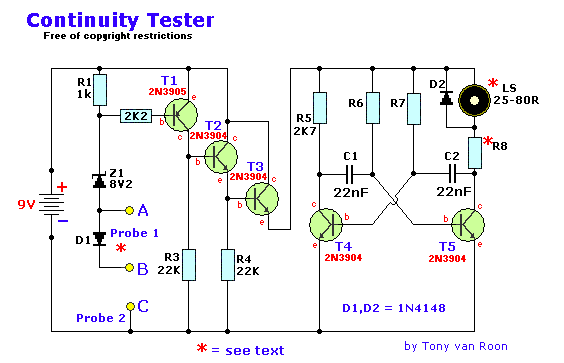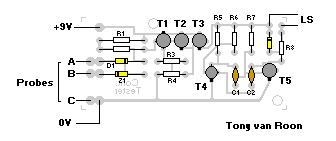Continuity Tester

Parts List:
R1 = 1K
D1,D2 = 1N4148
R2 = 2K2
Z1 = 8V2, 1/4 watt
R3,R4 = 22K
T1 = 2N3905 (PNP)
R5 = 2K7
T2,3,4,5 = 2N3904 (NPN)
R6,R7 = 56K
9volt Alkaline battery
R8 = *See text
suitable loudspeaker
C1,C2 = 22nF
housing & probes
An on-off switch is unnecessary. D1 is used when the battery
is brand-new and giving over the nominal 9volt, T1, T2 and T3
acting as the switch for supplying power to the multivibrator.
Design Considerations:
Several simple circuits were tried -- a lamp, battery and probes still demanded
the attention of the eyes; replacing the lamp with a buzzer was more successful
but needed some three to four volts and gave no indication of a series
semiconductor junction if the polarity was correct while the current flow was
large enough to damage the more delicate devices within the circuit under test.
An extension of the principle to operate an astable (multivibrator) type of
oscillator gave good audibility but would operate from zero through to several
thousands of ohms and so was too general an indication.
A set of specification was becoming apparent; (1) probe current to be small; (2)
probe voltage to be as low as possible, preferable less than 0.3V to avoid
seeing germanium or silicon junctions as a continuous circuit; (3) no on/off
switch to be used.
The above circuit was the result and several have been designed and are earning
their keep for both "heavy" electricians and electronic technicians.


The pcb pattern above is shown full-size at 73mm x 33mm (2-7/8" x 1-1/4")
How it works:
Starting with a 9 volt supply, when the probes are shortcircuited there is a 8.2
volt drop accross the zener diode Z1 leaving a maximum of 0.8 volt across R1.
Aplication of Ohms' Law shows that a maximum current of 0.8/1,000 = 0.8 mA lows
via the probes and this satisfies the first design requirement of low probe
current.
T1 is a silicon type and the bse-emitter voltage will need to be about 0.5 to
0.6 volt to forward-bias the junction and initiated collector current. With a
maximum of 0.8 volt availabe across R1 it is seen that if a semiconductor
junction or resistor is included in the outside circuit under test and drops
only 0.3 volt then there will be 0.5 volt remaining across R1, barely enough to
bias T1 into conduction.
Assuming that the probes are joined by nearly zero resistance, the pd across R1
is 0.7 - 0.8 volt and T1 turns on, its collector voltage rising positively to
give nearly 9 volt across R3. T2 is an emitter follower and its emitter thus
rises to about 8.3 volt and this base voltage on T3 (a series regulator circuit
or another emitter-follower if you prefer it) results in some 7.7 volt being
placed across the T4 - T5 oscillator circuit. All the transistors are silicon
types and unless the probes are joined, the only leakage current flows from the
battery thus avoiding the need for an On-Off switch. When not in use, the
battery in the tester should have a life in excess of a year. My own unit lasted
for more than 2 years with one Alkaline battery.
Descriptive Notes:
The output from the speaker is not loud but is more than adequate for the
purpose. I used a small transistor radio loudspeaker with an impedance of 25 -
80 Ohms. The resistance should be brought up to 300 ohms by adding series
resistor R8. Example, if your speaker is 58 ohms, then R8 = 242 ohms.
An experiment worth doing is to select the value of either C1 or C2 to produce a
frequency oscillation that coinsides with the mechanical resonant frequency of
the particular loudspeaker in use. Having choosen the right value, which
probably lies in the range of 10n - 100n, the tone will be louder and more
earpiercing. A "freewheel" diode D2 is connected across the transducer since
fast switching sction of the oscillator circuit can produce a surprisingly high
back e.m.f. across the coil and these high voltages might other wise lead to
transistor damage of breakdown.
Zener diodes do not provide an absolutely constandt volt-drop regardless of
current; at the 0.8 mA design current an 8.2 volt diode will quite possibly give
only about 8.0 volt drop since test current for zener selection and marking is
typically 5 mA or more. A further possible source of error is the battery; the
one suggested nominally provides 9V but a brandnew one may be as much as 9.5 to
9.8V until slightly run-down and this "surplus" voltage, combined with an
"under-voltage" znere volt-drop will leave considerably more than the forecast
voltage available at the probes. A silicon diode D1 is therefore connected in
series with the zener to decrease the probe voltage by a further 0.6 volt or so.
During your final testing and before boxing your circuit, the most suitable
connection, A or B, is selected for the positive probe wire. The aim is to have
the circuit oscillating with short circuited probes but to stop oscillation with
the least amount of resistance or the inclusion of a diode (try both ways)
between the probes.
No sensitivity control is fitted because I don't think it is worthwhile nor
necessary and would spoil the simplicity of the circuit.
There is no easy way to proof the unit against connection to the supply. Be
careful if checking AC line wiring and switch off first. In a similar way, if
checking electronic apparatus for unwanted bridging between Veroboard tracks,
for instance or a suspected crack in a PCB (Printed Circuit Board) track switch
off power first also. Good luck!
Title: Continuity Tester
electronic circuit
Source: www.electronics-lab.com
Published on: 2005-02-10
Reads: 934
Print version: ![]()
Other electronic circuits and schematics from Test and measurement
-
XTal Tester
-
Decibel Meter
-
Crystal Tester
-
AC Line Current Detector
-
Function Generator
-
Led display digital Voltmeter
-
Frequency Comparator
-
Oscilloscope testing module (huntron circuit)
-
XTal Tester
-
Audio level meter (vumeter)
